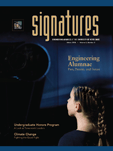 Work
Hard. Play Hard. Work
Hard. Play Hard.
Work Hard. Play Hard. In one of the research
projects led by Surendar Chandra, assistant professor of
computer science and engineering, it might be hard to tell
the difference ... even if you’re watching the students
in action. Chandra, along with Adele
Fleury and Adam Lusch, two engineering undergraduates working on this independent
study, have been collecting information to see how people
involved in multi-player games using handhelds, such as Nintendo® DS,
impact other wireless users.
Wireless networks are ubiquitous
in many organizations and most universities. Gamers create
a wireless network among themselves without using, or necessarily
requesting, permission from network administrators. So it
is important to understand the impact of gamers on the rest
of the network, in this case, the Notre Dame campus.
During
their experiments, the team found that Nintendo DS usage
had a negligible effect on User Datagram Protocol (UDP) traffic,
one of the core protocols for the Internet. However, interference
to Transmission Control Protocol (TCP) traffic was dramatic,
as throughput for Web users dropped from just over 5 Mbps
to between 2 and 3 Mbps, even though the volume of game data
was not high. Fleury and Lusch, with the help of fellow undergraduates,
such as Vincent Thomas (B.S., CSE ’07, shown here),
who took time out of their busy schedules to “play,” found
that the Point Coordination Function (PCF) used by Nintendo
to arbitrate channel access interacted with the Distributed
Coordination Function (DCF) of typical wireless access points,
causing major interference with the wireless traffic of other
local network users.
The team’s findings will be published
in a paper titled “Do Nintendo Handhelds Play Nice?
An Analysis of Its Wireless Behavior” in the proceedings
of the Sixth Annual Workshop on Network and Systems Support
for Games (NetGames 2007). Hosted by the Centre for Advanced
Internet Architectures, NetGames will be held September 19-20,
2008, in Melbourne, Australia.
|

